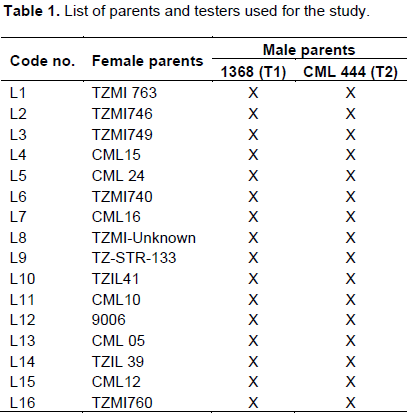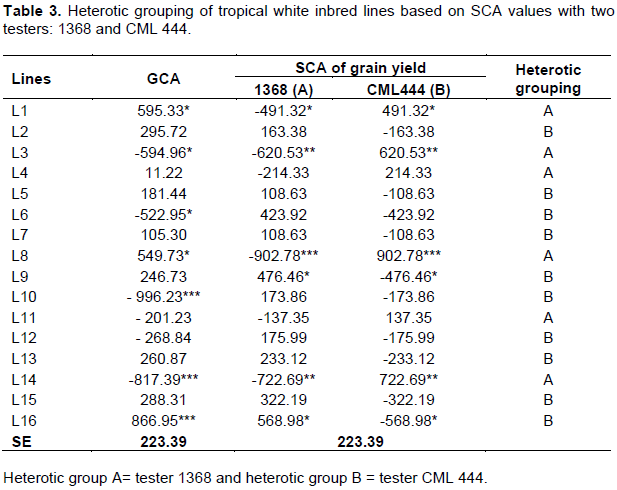ABSTRACT
A line x tester mating design involving sixteen white maize inbred lines as females and two testers as males generated thirty-two single crosses. These hybrids plus three checks were evaluated using a 5 x 7 alpha lattice design replicated twice at the University of Ghana, WACCI research farm during 2015/16 offseason using drip irrigation. The objective of the study was to: assign the tropical inbred lines into heterotic groups. Based on the SCA effect for grain yield, the lines were separated into two heterotic groups. The lines L1, L3, L4, L8, L11 and L14 belonged to tester group 1368, while L2, L5, L6, L7, L9, L10, L12, L13, L15 and L16 belonged to heterotic group of CML 444. This is useful for the development of hybrids and synthetic varieties. Thus, the information generated in the present study will be useful for breeders who want to improve yield and yield-contributing traits of maize.
Key words: Hybrids, heterotic group, line x tester (LxT), maize, yield.
Knowledge on the genetic heterogeneity and progeny performance, are significant for deciding breeding schemes, assigning the parental lines, defining heterotic groups, and predicting future hybrid performance. Thus, information on genetic diversity among genetic materials has an utmost importance for hybrid maize breeding programmes for development of lines, the assigning of lines into different heterotic groups and the preference of testers for hybrid combinations (Xia et al., 2004). Thus, assigning of maize lines into different heterotic group is very vital for hybrid breeding programmes in giving information about the germplasms (Hallauer et al., 2010). Melchinger (1999) proposed that, when a large number of inbred lines is available and proven testers exist, the relative performance of the lines in testcrosses with proven testers can be used as a main criterion for grouping of the lines. Vasal et al. (1992a, b) used this approach to evaluate the performance of testcrosses of 92 tropical and 88 subtropical maize inbred lines with two dent and two flint tester lines. In developing countries, use of available genetic materials and application of available crop improvement methods to improve yield and yield stability are required to meet the increasing demand of improved maize hybrids (Dhliwayo et al., 2009; Morris et al., 1999).
Heterotic effects of the maize lines and their allocation into well-known heterotic groups is the secret for the success of a maize breeding programme, which would give utmost exploitation of heterosis. The objective of the study was to: classify the tropical inbred lines into heterotic groups.
Description of experimental area
The experiment was carried out during 2015/16 offseason using drip irrigation at, West Africa Centre for Crop Improvement Research Field, University of Ghana. The University is located at 5.6508° N, latitude and 0.1869° W longitude and an altitude 97 m above sea level (m.a.s.l).
Genetic materials used for the study
Eighteen white tropical maize inbred lines with diverse genetic backgrounds were selected from the pool of inbred lines at the West Africa Centre for Crop Improvement (WACCI). This comprises of ten lines from the International Institute for Tropical Agriculture (IITA), six from International Maize and Wheat improvement Center (CIMMYT) and the two testers 1368 from IITA and CML 444 from CIMMYT maize breeding programmes. The 16 inbred lines were crossed to the two testers using the line by tester method (Table 1) and it generated 32 (16 x 2) cross combinations.
Experimental design and field evaluation
The 32 F1 crosses including the hybrids between the two testers, one popular open pollinated variety and a standard hybrid checks were evaluated for their agronomical performance using a 5 x 7 alpha lattice design at WACCI Research Field, the University of Ghana under irrigation system during 2015/2016. The genotypes were planted in two- rows plots, 5 m long with spacing of 0.75 m between rows and 0.5 m spacing between plants within a row. Three seeds were planted per hill, and then thinned to two plants per hill after three weeks of planting, giving 22 plants per row or 44 plants plot-1, to get a total plant density of 53333 plants ha-1. The experiment was managed using normal agronomic practices (planting, irrigation, thinning, fertilization, weeding and insect controls) from sowing to maturity.
Data analysis and procedures
Analysis of variance for all agronomic parameters studied was calculated using the PROC GLM procedure and test for significant differences among the genotypes was performed using SAS software (SAS, 2002). Traits that showed significant differences among genotypes were further partitioned into crosses, checks and check vs. crosses using (SAS, 2002). Traits that showed significant differences among crosses were partitioned into three components, namely females in crosses, males in crosses and female x male in crosses (Kempthrone, 1957; Singh and Chaudhary, 1985). The crosses means were adjusted for block effects as analyzed according to lattice design (Singh and Chaudhary, 1985) and used to perform combining ability analysis.
Genetic variability of genotypes, crosses, crosses vs check, lines, testers and line x testers and heterotic grouping of tropical white inbred lines are given in Table 2 and Table 3, respectively.
The result showed that genetic variability of GCA for lines were highly significant at P ≤ 0.001, for days to 50% anthesis and silking, plant height, ear height, plant aspect, ear length, number of kernel rows ear-1 and number of kernels row-1. Highly significant differences at P ≤ 0.01 were detected for anthesis-silking interval, maize streak virus disease, ear rot and grain yield. In addition, significant differences (P ≤ 0.05) were observed for husk cover.
The mean squares due to GCA for testers were significant P ≤ 0.001, for days to 50% anthesis and ear length, significant at P ≤ 0.01 were mean squares for anthesis-silking interval, plant aspect and number of kernel rows ear-1, and significant at P < 0.05 were days to 50% silking, plant and ear height. The GCA mean squares for testers were not significant for husk cover, ear rot and number of kernels row-1.
The line x tester (SCA) mean squares showed significant differences at P ≤ 0.001 for plant height, ear length and number of kernels row-1, and significant differences at P ≤ 0.05 for days to 50% silking, ear height, number of kernel rows ear-1 and grain yield. No significant differences was observed for days to 50% anthesis, anthesis-silking interval, plant aspect, maize streak virus disease score, husk cover and ear rot.
Clustering of tropical white maize inbred lines into heterotic groups
Assigning inbred lines into heterotic groups is a vital step
in a hybrid-breeding programme, which can provide maximum heterosis exploitation. The relative performance of inbred lines in crosses with divergent testers of known origin has been commonly used to assign maize inbred lines into heterotic groups (Hallauer et al., 1988). Significant GCA and SCA effects for grain yield were detected among the tropical white maize inbred lines. The SCA effect for grain yield was considered to be a major criterion for classifying the inbred lines. The testers were able to classify 16 of tested inbred lines into two heterotic groups based on SCA effects. Therefore, inbred lines under this study were assigned into two heterotic groups based on SCA effects of mean grain yield (Menkir et al., 2004; Vasal et al., 1992a,b). An inbred line, which had negative SCA effect with tester 1368, was assigned to heterotic group A (1368) whereas, an inbred line which had negative SCA effect with tester CML 444 was assigned to heterotic group B (CML 444). All the inbred lines under study were assigned to two heterotic groups. Among the sixteen tropical white inbred lines, six inbred lines L1, L3, L4, L8, L11 and L14 were grouped into heterotic group A (1368) while ten inbred lines L2, L5, L6, L7, L9, L10, L12, L13, L15 and L16 were grouped into heterotic group B (CML 444). Thus, in order to exploit genetic diversity and then heterosis during hybrid variety development when using these inbred lines, one parent should come from the six inbred lines belonging to tester heterotic group A while the other parent should come from the ten inbred lines belonging to tester heterotic group B. Therefore, inbred lines with same heterotic groups and positive GCA effects can be used in the development of synthetic varieties while those in different heterotic groups can be used in the development of hybrid varieties to maximize on heterosis.
The two testers included in the study separated effectively inbred lines into two heterotic groups. Among sixteen inbred lines included in the study, six were assigned into tester heterotic group 1368, while ten were assigned to tester heterotic group CML 444. This will be useful for developing hybrids and synthetic varieties in future breeding. Breeding programmes can take advantage of this information on combining ability to find best breeding strategy for developing high yielding lines and hybrids.
The authors have not declared any conflict of interests.
REFERENCES
|
Singh RK, Chaudhary BD (1985). Biometrical methods in quantitative genetic analyses. Kalyani Ludhiana, New-Delhi.
|
|
|
|
Dhliwayo T, Pixley K, Menkir A, Warburton M (2009). Combining Ability, Genetic Distances, and Heterosis among Elite CIMMYT and IITA Tropical Maize Inbred Lines. Crop Sci. 49:1201-1210.
Crossref
|
|
|
|
|
Hallauer AR, Marccelo J, Carena JB, Mirnda F (2010). Quantative genetics in maize breeding. (M JC. Prohens, Jamie, Fernando Nuez, Ed.) (6th ed.). Springer, New York Dordrecht Heidelberg London.
|
|
|
|
|
Hallauer AR, Russell WA, Lamkey KD (1988). Corn breeding. In: Sprague GF, Dudley JW (eds) Corn and corn improvement. Agronomy Monograph no. 18, 3rd edn. ASA-CSSA-SSSA, Madison, Wis. pp. 463-565.
|
|
|
|
|
Kempthrone O (1957). An introduction to genetic statistics, John wiley and Sons, New York. John Wily and Sons.
|
|
|
|
|
Melchinger AE (1999). Genetic diversity and heterosis. In: Coors JG, Pandey S (eds) The genetics and exploitation of heterosis in crops. CSSA-SP, Madison, Wis. pp. 99-118.
|
|
|
|
|
Menkir A, Melake-Berhan A, Ingelbecht CI, Adepoju A (2004). Grouping of tropical mid-altitude maize inbred lines on the basis of yield data and molecular markers . Theor. Appl. Genet. 108:1582-1590.
Crossref
|
|
|
|
|
Morris ML, Tripp R, Dankyi AA (1999). Adoption and Impacts A Case Study of the of Improved Ghana Grains Maize Production Development Project Technology: Adoption and Impacts of Improved Maize Production Technology : A Case Study of the Ghana Grains. Economics Program paper 99- 01. Mexico, D.F.: CIMMYT.
|
|
|
|
|
SAS (2002). SAS Institute, Inc., SAS users' guide. Version 9.0th ed.Cary, NC. 27513, USA. Cary.NC.
|
|
|
|
|
Vasal SK, Srinivasan G, Pandey S, Cordova HS, Han GC, Gonzalez FC (1992a). Heterotic patterns of ninty-two white tropical CIMMYT maize lines. Maydica pp. 259-270.
|
|
|
|
|
Vasal SK, Srinivasan GS, Han GC, Gonzalez FC (1992b). Heterotic patterns of eighty-eight white subtrobical CIMMYT maize lines. Maydica pp. 319-327.
|
|
|
|
|
Xia XC, Reif JC, Hoisington DA, Melchinger AE, Frisch M, Warburton ML (2004). Genetic Diversity among CIMMYT Maize Inbred Lines Investigated with SSR Markers: I. Lowland tropical maize. Crop Sci. pp. 2230-2237.
Crossref
|
|


